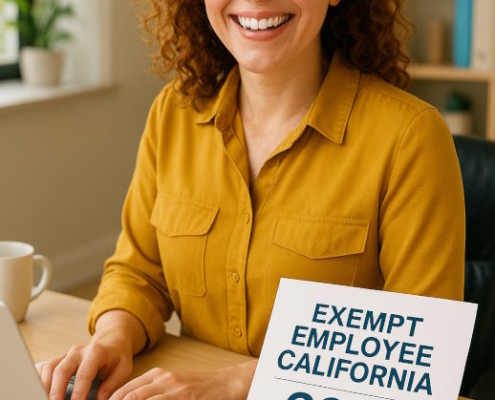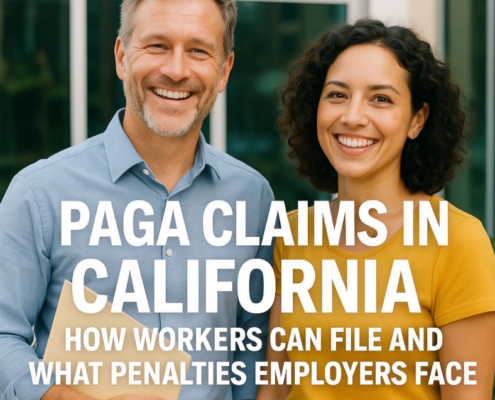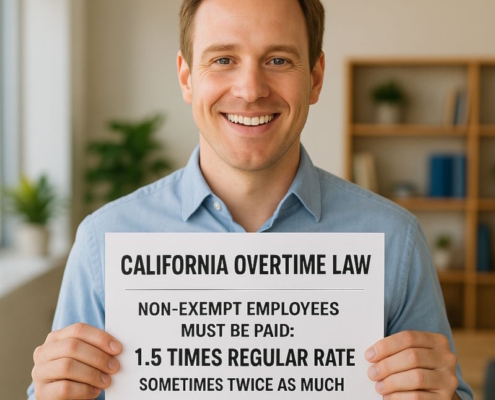What Is Joint Employer Rule in California?
Under the joint employer (aka: joint employment) rule, a worker can sue a company other than the direct employer for wage and hour violations.
By Brad Nakase, Attorney
Email | Call (800) 484-4610
A joint employer means when one company, called the primary employer, is so connected to another company, known as the secondary employer, that employees of the secondary company may also be considered employees of the primary employer. One example of joint employers may be found in the relationship between contractors and temporary staffing agencies. Another joint employer relationship may be found between contractors and subcontractors.
The test for joint employment is to determine if the primary employer “employ” the worker: (1) to exercise control over wages, hours, or working conditions, directly or indirectly, or through an agent or any other person; (2) to “suffer or permit to work”; or (3) to engage. Martinez v. Combs, 49 Cal.4th 35 (2010). The key factors in determining joint employer are:
- If the primary hires workers or has a say in the selection process
- If the primary compensates the workers or assigns their compensation
- If the primary controls the activities of the workers on a day-to-day basis or supervises performance
- If the primary has the authority to discipline workers, terminate employment, or enforce workplace rules
In this article, our attorney for employers discusses joint employer liability as follows:
What are the risks of co-employment?
A joint employment relationship may become problematic when the primary employer is held responsible, or liable, for the secondary employer’s labor violations.
Let’s imagine a staffing agency that supplies companies with workers during hectic times of the year, such as during seasonal highs or the holidays. While the staffing agency does not onboard these workers directly, it remains a question whether the agency can be held liable in the event one of the workers hurst themselves on the job or submits a complaint about not getting paid. In this scenario, should the staffing agency be worried?
There are at least two joint employer concepts in California that might place responsibility on the companies that contract with staffing agencies or labor contractors. Section 2810.3 of the Labor Code states that some employers might be considered jointly legally responsible for labor violations that contractors like staffing agencies may commit. A company with twenty-five or more workers that partners with such an agency will have shared legal responsibility and civil liability for all workers that the staffing agency provides. This liability is for the following:
- Inability to ensure employees’ compensation coverage
- The payment of wages
However, under this law, joint liability is not relevant for the following:
- A bona fide apprenticeship program, hiring hall, or labor organization run by a union agreement
- A bona fide community-based nonprofit organization that provides services to workers
- A motion picture payroll services company
- Workers who are independent contractors
- In certain situations, a third party that participates in an employee leasing agreement
- A homeowner who sponsors services at their home or the owner of a business based at home
- Certain household movers, motor carriers, motor clubs, and cable operators
Section 2810.3 of the Labor Code states that an aggrieved worker must provide the company that works with the hiring agency no less than thirty days’ warning before submitting a civil suit against the company for violating this law.
When a company exhibits indirect or direct control over an employee provided by a staffing agency or intermediary entity, joint liability for wage and hour claims can arise.
In the case Medina v. Equilon Enterprises (Sept. 2021), the court decided that there is joint employment when the company has enough power over the intermediary to dictate, if indirectly, the hours, working conditions, and wages of the worker. In this scenario, Shell Oil established a contract with a Multi-Site Operator (MSO) so that the latter would operate its gas station. Mr. Medina worked for the MSO. The multi-site operator was in charge of firing, hiring, disciplining, training, and maintaining payroll. Shell offered in-depth instructions on how to follow employment laws. The MSO was not permitted to alter the duties of employees, including Mr. Medina. Accordingly, the court decided that the MSO and Shell were joint employers who were therefore responsible for the unpaid wages of Mr. Medina. This is because Shell had enough power over the MSO to indirectly control Mr. Medina’s hours, working conditions, and wages.
A California company that makes use of an intermediary company to provide employees should be conscious of the risks associated with joint employment. Specifically, the company should go over issues related to being in compliance with the state’s workers compensation laws, labor laws, as well as indemnity in the parties’ written agreement related to services.
The biggest risks associated that come with joint employment relationships involve the primary employer taking on the secondary employer’s employment liabilities. The following are some examples:
- Labor violations. According to the Fair Labor Standards Act, a primary employer can be held responsible for the secondary employer’s failure to pay employees wages or overtime.
- Employment harassment and discrimination. According to a number of state and federal anti-discrimination laws, a primary company may be found responsible if the secondary employer harasses or unlawfully fires one of its workers based on a protected class (age, sex, race, disability, religion, etc.)
- Medical leave obligations. A primary employer may not have enough employees to support FMLA obligations, but joint employers may both have FMLA obligations if their joint workforce is big enough. Also, if a secondary does not comply with existing FMLA obligations, a primary may be held liable.
- Collective bargaining and union obligations. According to the National Labor Relations Act, a joint employer can lead to a primary being found liable for the secondary’s unfair labor practices. It may also result in the primary being forced to comply with any collective bargaining agreement of the secondary. If a secondary’s workers are involved in an employment dispute, a joint employer can give up the primary’s right to avoid boycotting and pickets.
What does joint employer liability mean?
If an FLSA situation arises, then the two or more employers in a joint employer relationship share liability. This means that both the franchisor and the franchisee could be held responsible for any Department of Labor penalties assigned for the FLSA breaches.
Prior to this change in the rules, a court would assess to what degree employers were associated and then hold both parties responsible. The new rule provides a four-factor test that looks at the following:
- Which employer is in charge of hiring and firing
- Who decides on the employees’ pay rate and method of payment
- Which employer controls the employees’ work schedule and duties
- Who keeps employee records
It should be noted that none of the above factors is sufficient on its own for a joint-employment status. There should be some degree of the other elements involved.
In the past, joint employer liability meant that a franchisee and a franchisor might be held jointly responsible for any employee disputes brought under the FLSA. The rationale was that the franchisor determined how the franchisee interacted with employees and should be considered also liable.
Because a franchisor could be held liable for the supposed breaches of their franchisee, many franchisors chose to withhold assistance to their franchisees when it came to hiring, terminating, and retaining employees. As a result, the franchisees suffered in that they received less support from the franchisors.
How do I avoid joint employer liability?
To avoid joint employer liability, a company should have protections in the staffing agreement or subcontract. This agreement should state that the secondary:
- Is solely responsible for all training, including safety training
- Will comply with labor laws and will indemnify the primary for breaches
- Is solely responsible for recruiting, pre-employment testing and screening, maintaining personnel files, paying wages and benefits, providing personnel policies, withholding taxes, and maintaining insurance coverage
- Is solely responsible for setting schedules, directing daily activities, hiring, conducting performance reviews, and disciplining and terminating
This agreement should have an agreed-upon scope or duration. There should be procedures in place that indicate how managers of the primary interact with the secondary’s employees. If a safety violation happens, for instance, it may be permissible for the primary’s supervisor to remove the at-fault worker from the workplace but not to discipline them. Also, while it may be okay to put in quality control checks, it may not be acceptable to control the workers’ day-to-day activities. Managers and supervisors should be trained on how to maintain this balance. Possibly the best way to protect against joint employer liability is to make sure that staffing agencies or subcontractors understand and follow their legal obligations to their workers.
Have a quick question? We answered nearly 2000 FAQs.
See all blogs: Business | Corporate | Employment
Most recent blogs:
































